C421 came in three flavors at first – you could select OPA2227, AD8066 or AD8620 as the main opamp, which are also the choices JDS Labs offered for their cmoyBB and some of the most popular opamp choices for DIY amps. The option for AD8066 is later removed since not many buyers ordered it, but it is still available under special request.
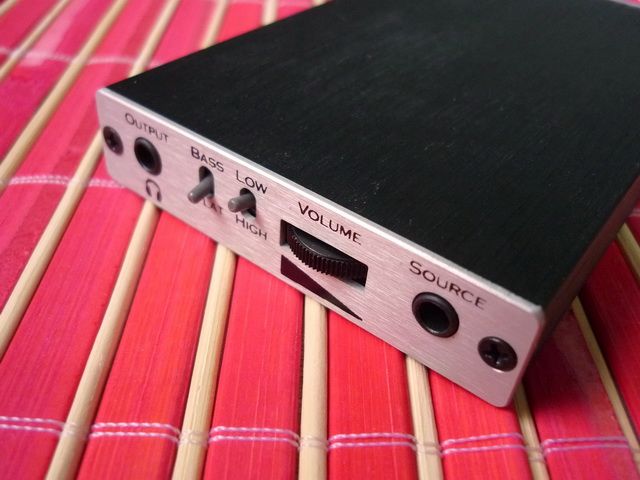
Spec and Features
Main opamp choice: OPA2227 or AD8620
Run-Time: 11+ hours
Charge Time: 2 hours to 80%, <5 hours to 100%
Frequency Response: +0.01, -0.41 dB (20Hz-20kHz)
SNR: > 110 dB (20-20kHz)
THD: < 0.0041%
Crosstalk: < -57dB
Output Impedance: *See ‘Impedance Talk’ section for more detail
Enclosure Size: 97.5 x 14.0 x 62.5mm
Dual Gain, 2.3x or 7.0x (+7.2dB or +16.9dB)
Bass Boost, +8dB peak
Low Battery Indication
0.1% Thin Film Resistors
1200mAh, 3.7V Li-Ion Battery
USB Powered Smart Charging
Synchronized +/-7V rails
Aluminum Enclosure
Price: US$184 for OPA227 or US$189 for AD8620
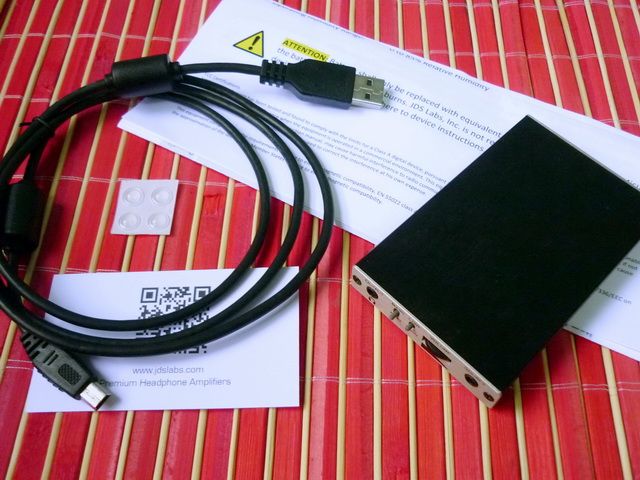
Build Quality and Accessories
Like everything JDS builds, the C421 has excellent build quality. The black aluminum case has the same texture as the Meier Audio Corda 3MOVE / Stepdance’s case, which almost feels like sandpaper in finish. It looks classy but not that type of surface you will want to put an iPhone’s smooth back cover against it without something sandwich in between. But then, it really isn’t that big of a deal. The face place is quite good as well, but I wish the logo / letter marking should have been darker and bolder. That is mainly just aesthetic and doesn’t affect the value of the amp in anyway. If I were to compare, I’ll say Leckerton Audio UHA-4’s casing finish would be something I am more preferred. It is ultra-smooth without any corner and all the cutting and holes for the switches are just about perfect. Not that C421 is bad in anyway, but there are still room for future improvement no less.
Accessories include a good quality USB cable for charging and 4 rubber feet – that’s something nice for JDS to include.
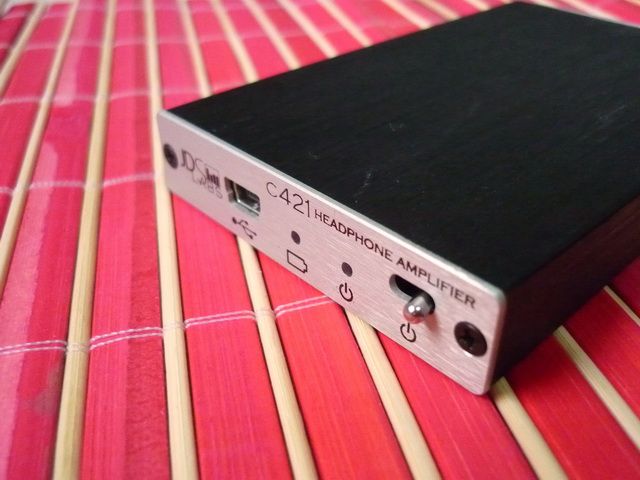
Would have been better if power LED is on the front plate
Layout
The front layout is nice. I generally prefer the input and output jack being further apart than they are together like the UHA-4. It gives more space for plug orientation as oversized and L-shaped plug isn’t that uncommon in the audiophile world.
One thing I’ll like to see is having all the switches (bass boost, gain and power) placed just a little inward on the PCB so they won’t stick out as much on the casing. Two or three millimeter more inward will be all there is needed.
The second thing I’ll like to see is the front facing LED indicators instead of the rear facing. On a few occasion I have forgotten to switch the amp off because I didn’t notice the LED is still lighted up since it is on the back of the amp. It would be nice to at least have the power led facing forward.
Battery life
The listed battery life is over 11hours, which is about right as I can regularly get between 12 to 14 hours out of it before needing a recharge. The overall length of time of course will change depends on both the load and the volume. When the battery is low, the battery indicator on the rear will light up, warning you there is less than an hour of battery left and it is about time to recharge the amp.
The internal Li-ion battery is identical to that of the old iPod 4G battery so replacement is totally possible, but the stock battery should at least last you a few years before you need to replace it.
Hissing + EMI
C421 is close to completely silence even with some of the most hiss prone IEM. There is virtually no hiss. Click and pop are also close to minimum. EMI, or cellphone interference, is also close to being perfect as the amp remains totally silence right next to a cellphone that is receiving incoming call (which EMI is at its worst). All and all, C421 passes the real world tests with flying color.

Size comparison: (top, left to right) iBasso D-ZERO, C421, iBasso T5; (bottom, left to right) FiiO E11, digiZoid ZO2.3, FiiO E6.
SQ
Both version of C421, as well as cmoyBB and O2 have been given at least 50 hours of burn-in before the review – no audible difference was detected on any of them.
Before we go ahead and discuss C421-2227 or C421-8620, I think it is important for us to reference back to other two amps JDS Labs is making, the cmoyBB and O2:
I have reviewed the cmoyBB almost 2 years ago and quite impressed by it (see the review here). It is one of the most impressive cmoy variance I have ever heard and well worth the asking price. Still it is not the reference portable amp of my choice as it sounds just a bit upfront and lush in a way – almost ‘fun’ sounding. It has more to do with the OP2227 used in cmoyBB as I have made note that AD8066 and (especially) AD8620 both sound more neutral (and have overall better performance) than OPA2227. For a very large part, I think I can say I have observed the same difference in the two version of C421. Since everything is equal in both versions except for the opamp, I think that is to be expected. Now let’s leave that part of the discussion for a later time and focus on the O2.
O2 is designed to be as good sounding to the ears as it is good to the measurements. You might not like NwAvGuys’ attitude and approaches toward some of the well established DIY’ers, but it is hard to argue that O2 isn’t an excellent amp of its own right. It is by far one of the most transparent amps I have heard of any price range yet it is not short on anything performance wise – soundstage, power, control and faithful to the source without any sense of coloration. It has become my reference of what neutral amp should measure up to, and naturally it is what C421 should measure up to as well.
Both version of C421 are easily some of the best sounding sub-$200 portable amp I have heard and without a doubt can compete with more expensive portable amp. Regardless of which opamp, they are powerful and close to being transparent. RMAA test reveals that both versions do measured very well. In fact, some of the best I have even measured and even close to (but not beating) the performance of O2 in most area. The results either mirror those that have been published by JDS, or close enough to O2 that would not worry me. The only area that isn’t impressive, so to speak, is the crosstalk measurement, but it is outperformed the published spec. One thing that RMAA doesn’t measure is the output impedance, which will be further discuss on the second to last section of the review.
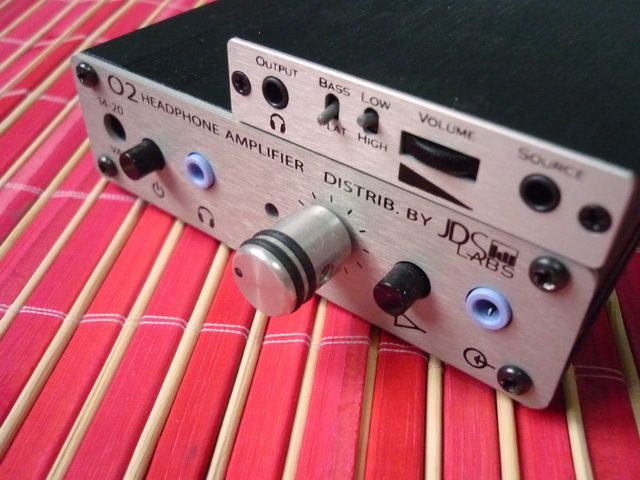
C421, on top of O2.
I have made a few observations in the Head-fi forum on both which I think are still very relevant and thus I am going to quote them instead of rewriting.
…It is almost like the last time I compared the stock cmoyBB (which is OPA2227 based) to the AD8620 rolled cmoyBB, except this times both C421 sound much better than both the cmoyBB in every way. Like last times, the AD8620 wins over OPA2227 for me again. Not something night and day, but enough to call out a winner.
However, this is not to say AD8620 crashes OPA2227 in every way. I love the AD8620, but I can understand why someone would find it V-shaped sounding and prefer the OPA2227 instead. It has more to do with the slight difference in presentation between the two opamps (and I had observed the same in cmoyBB as well) - AD8620 has really great soundstage and portrays the image in a very 3D fashion. In a way, it is almost better in imaging (especially in depth) than the O2 and that's quite an amazing feat on its own. OPA2227 on the other hand puts everything upfront with a sense of rich and warmness between the tones. If we were to take O2 as our reference for what 'totally neutral' / standard should be, then AD8620 would be the equivalence of what 3D TV meant to normal TV (where you get the surreal 3D effect) while OPA2227 would be equivalence of sitting close to a HD TV vs. at normal distance (where you get to see the fine detail in individual element but not quite so over the whole picture).
As mainly an IEM user where soundstage is generally more limited, the extra layer of depth that AD8620 brings to the table is a real killer feature to me. It just goes really well with all kind of IEM (*the synergy with Etymotic ER4S is unbelievably good for an IEM that is always considered to be flat sounding). But that same extra layer of depth might not be that appreciated for full sized headphone user (where soundstage is already good) or simply for those who rather prefer an upfront presentation. Instead, I would think they will find AD8620 adds a sense of hollowness to the presentation which might not be to their liking. That's probably why AD8620 is interpreted as V-shaping by some, even though the FR curve is perfectly flat for both opamps.
So what is my early conclusion? I'll still recommend C421 with AD8620 over OPA2227 for its more rounded presentation. But for those who rather like a little bit more richness over imaging, the OPA2227 based C421 could work out better for them. Both are really great sounding amps, and I think the choice is every bit personal preference as it is performance.
….
I think the most important point why I recommend AD8620 over OPA2227 is the fact that AD8620 gives much better imaging and soundstage to IEM (which is something IEM always seems lacking when compared to full size). OPA2227 on the other like to put thing upfront - it might seems wider on the side, but the true is you are not getting as much depth as you can. With IEM, where depth is generally a weak spot, the AD8620 offers something OPA2227 doesn't have. As for brightness - I won't say AD8620 is very obviously bright compared to OPA2227. AD8620 just handle the detail more delicately, and makes the listener listen to the detail more plainly. But the true is I can hear just as much detail in OPA2227 as well, but they are generally hidden behind / obscured by the richness of the tone and you'll have to pay more attention to find them out.
C421 vs. Ibasso T5 vs. Leckerton Audio UHA-4
…Volume matched using a SPL meter to wihtin 0.3dB of each other, I'll say there is no distinct advantage in SQ for T5. Overall, C421 (both AD8620 and OPA2227 version) sounds more detail and specious than T5, while T5 has the unique rich and smooth tone that usually associated with balanced amp (T5 has BTL ground, a type of active balanced ground). Technically, I'll say C421 is slightly ahead of T5, but the difference is small and quite subtle IMO…
…But as far as hearing goes, I have to say UHA-4 and C421 are very close in performance. Note, I choose OPA209 in my UHA-4 instead of the default AD8610 as I want to try a new opamp. I already have several AD8620/8610 amp in my collection and OPA209 seems to be very popular and well recommended.
For now, my comparison is limited to UHA-4 vs C421 (both AD8620 and OPA2227 version) and T5. As far as presentation goes, I'll say UHA-4-209 is closer to C421-2227 than it is to C421-AD8620. It shares more of an upfront sound than it is on imaging. However, UHA-4-209 has the smoothness closer to C421-8620. Overall, it seems to be a mix of C421-2227 and C421-8620, but closer to C421-2227. The most noticeable parts for me are two: 1) UHA-4-209 has great bass impact, on par with (if not slightly better than) C421-2227 and definitely more than C421-8620. This could be just because the former two are more upfront. 2) The resolving power and imaging (and thus soundstage wise) of both C421 are ahead of UHA-4-209. Not by much, but it is noticeable. As far as T5 goes, I have to say it is trailing behind the above three closely. The deciding factor for me to say T5 is just behind the three is that it doesn't have overall transparency / openness in soundstage as the other three. For T5, everything is placed closer in. However, one thing I like about T5 that is better than the three is that it has the smoothest presentation of all. I can pair it with any IEM and it will make the IEM sound good. On the other three, they tend to want to push it over-the-top and reveal all the flaws. This kind of smoothness seems to be more common among balanced amp (T5 has BTL-ground, similar to active balanced ground). Regardless, I think T5 is still technically not as strong as UHA-4 or C421, though very close.
Taking O2 as the reference, I'll say, for now, C421-8620 is ahead, follow very closely by UHA-4 and C421-2227, then T5…

Family portrait of JDS amps.
Bass Boost
Bass boost is what makes JDS Labs’ cmoyBB famous in the first place so naturally it is a ‘must-have’ feature on the C421. If you take a look at the two frequency graphs below, it is very apparent that the bass boost is more of a deep bass boost (*center around sub-bass, below 100Hz) that give rumble and body rather than a boom bass boost (*center around mid-bass, 250Hz region) that gives quantity. Both version of C421 has similar FR curves, starting under 1Khz, reaches 1.5dB @ 250Hz and 3dB @ 150Hz, then finally peaks at over 6dB @ 20Hz – which is quite impressive. While 6dB isn’t as high as the listed 8dB peak, it is still quite a lot and frankly enough for most.
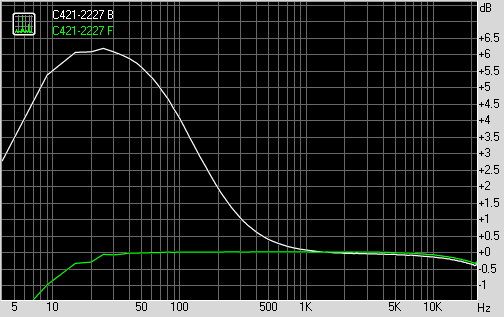

Bass begin to roll-off under 20Hz, but that is out of hearing range.
Impedance Talk
With all the praise, it is time for the bad news.
Just a rule of thumb, I’ll generally do some basic measurements when evaluating portable amps. RMAA will give some reference points for comparison but it is generally not detailed enough to give the full picture, and I can’t really afford (or know how to use) an oscilloscope or audio analyzer. But as far as RMAA goes, as I have mentioned, C421 is doing very well. The ‘problem’ is when I started to measure the output impedance - which I generally carry out using a 1kHz test tone and a 47ohm fix load, then calculate output impedance using the voltage difference between loaded and unloaded output. The first measurement is so wild that I thought my multimeter was broken and I have to get a second, more precise multimeter to confirm the measurement. The final output impedance is calculated at around 10.5 ohm. The test was repeated using a different source with 100Hz and 500Hz test tone and the results are similar. That’s quite different from the >0.1ohm once listed in spec.
I have contacted JDS Labs for my measurement result and they later confirmed my result that the output impedance is indeed significantly higher than what they have previously estimated on the simulator during prototyping. I think it is only fair if they have the chance to explain it to you and not through my words, so I am not going to elaborate too much on the detail. But so far, I think the smoking gun for the high output impedance is an unforeseen compromise arose from trying to design an amp that protects itself from user error, which ends up making it less than ideal. However, like I have said to John @ JDS Labs, I really have nothing bad about C421 to say. It is an excellent sounding amp before I know about the output impedance issue and I don’t see why I would want to change my opinion over it just yet. Yes, C421 will not have nearly as good a electronic dampening as many other amps, but it is not like HeadRoom Total BitHead (which also has high output impedance, though not as high as C421) where the lack of control and bass roll-off really bothers me. It is definitely a weak spot but it is also only a single aspect of C421 and overall, I am still very happy at what I have listened for the last few months - and I’ll keep listening.
[Update] See JDS Labs explanation to the high impedance issue on the End Note 2.
Ending
Oh, C421 (or more precisely C421-8620) would have been the most perfect slim portable amp I have ever used so far with the right combination of performance and value for money, but it is not to be. Well, not 100%. It will be silly to say people won’t start to worry about output impedance at this point even though some of them might have been very happy with their C421 before reading this review. No, this is not a witch hunt and frankly, I am not that worry about output impedance myself, though I should have - you know, being an IEM user and all with a large collection of IEM that are low in impedance. But I also know my IEM sounds great with C421 and see no reason why it shouldn’t be recommended as one of the best sounding slim amp in the sub-$200 category. That’s my opinion.
*Thanks to JDS Labs for the C421-2227 loan unit.
*End Note 1: in case you have no idea who NwAvGuy is – he is the ‘mad scientist’ equivalent of electronic engineer who took upon himself the duty to debunk all audiophile electronic myths and expose the dark underside of audio business using measurement and science. While I did just refer him as mad scientist, I don’t mean anything ill toward him, just his rather radical approach to the problem and how he poses himself to the world. While there might be a lot of madness in his work, there is undeniably a lot of goodness as well. For example, O2 is his challenge to both mainstream and DIY amp designer for designing a reference quality portable amp that is both affordable and purely based on objective criteria/measurement.)
*End Note 2 - From JDS Labs (June 25th, 2012), as posted on Head-fi.org.
We measured every published characteristic of c421 and documented the test setup, except for output impedance ("output-Z"). The output-Z spec was listed without test setup notes, as it was a theoretical figure from our simulated LTSpice IV model. The entire c421 circuit, from the power stage, through the opamp output stage, was simulated before we built a prototype.Outputs of c421 are coupled to the headphone jack using strong SMT ferrites. These are the components responsible for output-Z. The purpose of these parts is twofold. First, they result in stable opamp phase response well into MHz territory (as gain naturally diminishes), even when loaded with a long or messy audio cable.Second, it's critical in a voltage boosted design to minimize radiated emissions in accordance with international guidelines. We spent months getting this right. c421 is clean and well behaved because we sought design advise from an expert in EMI regulations. This man was singly responsible for saving a multimillion-$ audio company from huge FCC fines about a decade ago. He asked that I keep his name anonymous. Anyway, output ferrites are an easy way to keep MHz+ noise from escaping a circuit. While c421 is measurably clean, we left these parts in place after prototyping because they're low cost and keep EMI noise to a minimum. Win-win...until ClieOS measured a specification we had not confirmed.DC resistance of these ferrites is R < 0.1 ohms. But impedance is |Z| = |R+jX|, and it was my failure to verify the true output-Z by measurement. The manufacturer supplied datasheet and LTSpice simulations made the reactive component appear insignificant. Unfortunately, that was not true at all. Actual impedance is right around 10-11 ohms, as ClieOS measured. We immediately edited c421's listed specifications.If by chance this specification error bothers someone, there's any easy fix to yield the expected measurement. Shorting out the ferrites will result in output-Z of < 0.1 ohm. But considering the tone of this review (and others), we will not alter the design of c421. The amp is well established and it would be confusing for units to exist with different specifications. And as explained above, the parts exist for a reason.Finally, I think there is some slight confusion when ClieOS mentions "the high output impedance is an unforeseen compromise arose from trying to design an amp that protects itself from user error". I believe this comment is in reference to a PM discussion we had about a feedback loop resistor, which does not affect output-Z. Here's the PM I sent in response to ClieOS's question about the purpose of resistors 14 and 15:c421 was designed to minimize failures due to customer error. R14 and R15 are for IC protection when an input cable is mistakenly connected to the output jack. This happened frequently before endplates were manufactured. The OPA2227 survives, but AD8620/AD8599 and others are not always happy (usually, but not always).R801 and R802 further protect the IC mechanically, via 150 ohm resistive load when the output/headphone cord is unpplugged. But mechanical protection obviously cannot protect against reversed cables.
Impedance Talk
I have contacted JDS Labs for my measurement result and they later confirmed my result that the output impedance is indeed significantly higher than what they have previously estimated on the simulator during prototyping. I think it is only fair if they have the chance to explain it to you and not through my words, so I am not going to elaborate too much on the detail. But so far, I think the smoking gun for the high output impedance is an unforeseen compromise arose from trying to design an amp that protects itself from user error, which ends up making it less than ideal. However, like I have said to John @ JDS Labs, I really have nothing bad about C421 to say. It is an excellent sounding amp before I know about the output impedance issue and I don’t see why I would want to change my opinion over it just yet. Yes, C421 will not have nearly as good a electronic dampening as many other amps, but it is not like HeadRoom Total BitHead (which also has high output impedance, though not as high as C421) where the lack of control and bass roll-off really bothers me. It is definitely a weak spot but it is also only a single aspect of C421 and overall, I am still very happy at what I have listened for the last few months - and I’ll keep listening.





